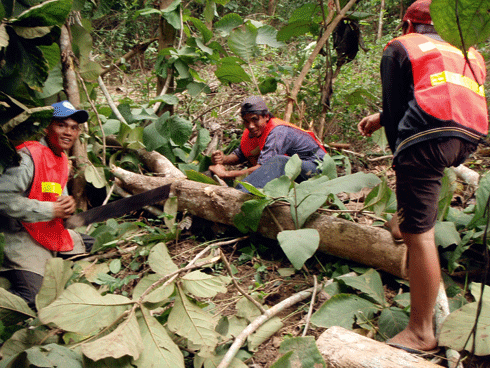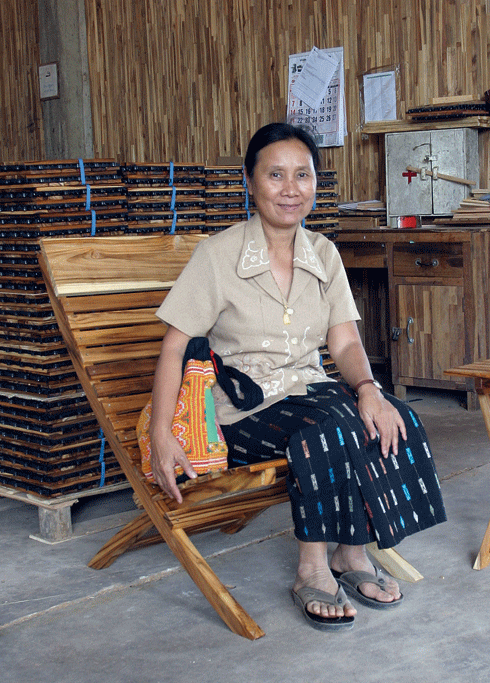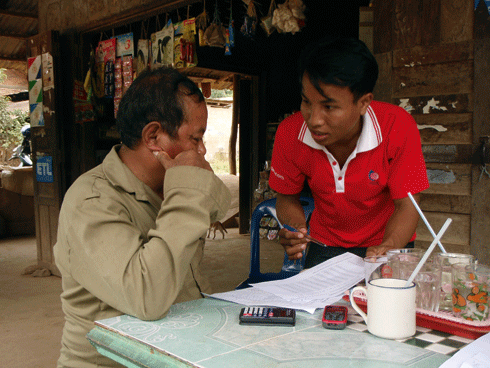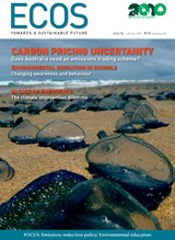
|
Published:
Small plantations offer ‘teak break’ for Lao farmers
A pilot program in northern Laos is sowing the seeds of a sustainable teak plantation industry, improving local villagers’ livelihoods and reducing the timber industry’s reliance on trees from native forest.

|
|
Local people harvesting plantation teak in new safety vests supplied by program partners. Credit: Richard Laity
|
Western consumers might best know teak as a durable timber used for outdoor furniture, but for poor rural people in Laos, a small teak plantation means much more. It is a valuable cash crop that can make the difference between whether or not their children go to school.
Thanks to a range of government incentives and recognition of the strong demand and returns for teak, small teak plantations have been springing up on the hills around the northern city of Luang Prabang at a rapid rate over the past 20 years.
In the small village of Ban Kok Gniew, the Luang Prabang Teak Program is providing farmers with the skills they need to manage and market their product directly to timber processors and link them with international markets.
The program is being implemented by the Lao Forest and Trade Platform – a collaboration between the WWF and The Forest Trust (TFT) – and the Luang Prabang Forestry Section.1,2 It includes a teak growers’ cooperative, with more than 40 members, and currently covers about 100 hectares of plantations. After two years of training and establishing markets, farmers say their returns have doubled. Processors have also benefited by reduced costs.
An Australian forestry adviser with the program, Richard Laity, says Forest Stewardship Certification (FSC) – now demanded in international timber markets – should be finalised this year.
Better returns for smallholders
Teak is a profitable enterprise, returning from US$5–20 per tree after 15 years. This increases exponentially as the valuable heartwood matures – some 35-year-old trees are worth more than US$500.
In the small village plantations, however, trees rarely have a chance to reach such an age. Most are harvested after 15 to 25 years – when money is needed – rather than at the best time for tree value and forestry management. Such trees are typically sold to meet extra expenses such as school fees or funeral costs.
The conventional way of marketing for farmers with no direct access to processors is to sell their trees through traders, who select what they want and make an offer based on quality and distance from the road. Under this system, farmers receive prices well below market value, and are forced to sell their best and biggest trees prematurely. Laity says this degrades the quality and vigour of the plantation, meaning that plantations are being managed well below their productive capacity.
Farmers involved with the sustainable teak program, however, are taught how to measure log volume, and so are able to sell their logs directly to processors on a volume basis.
The first trial sale of 50 trees (10 cubic metres of logs) to a Vientiane-based processor delivered a better price for the farmers and reduced processing costs by about one-third. This year the group made a significant sale of 146 cubic metres of round logs at an average price of US$83 per cubic metre – well above the price they could expect under the previous system.
For smallholder farmers such as Mr Somphet, being able to sell his trees at a good price means he can afford to send his children to school. He says the increase in income has been made because he can now sell the smaller and defective trees that previously no one would buy.
Teaching sustainable practice
Training, which focuses on practical aspects of sustainable forest management, is a critical part of the program. It helps farmers to improve their skills and demonstrate that they are meeting FSC criteria.
Mrs Bounchan Phatahmith and her husband manage the finances for the teak growers’ cooperative. She says the program has helped the entire community through ‘teaching the technical aspects of growing teak correctly, such as the need for thinning and pruning, to meet international market requirements’.

|
|
Mrs Bounchan and a chair made from LPTP supported village teak. Credit: Svesson
|
With more than 10 000 ha of teak plantations already being grown in the province, mostly by smallholder farmers with average holdings of about one hectare, there is plenty of scope to expand into other villages.
Laity says that as well as the income benefits for local farmers, improving plantation management has environmental benefits.
Under conventional plantation management, soil erosion is often a problem due to the combination of heavy rainfall, trees planted too densely on steep slopes, intensive clearing of the understory and frequent burning. But, after only one year of training, farmers participating in the program have significantly reduced burning – the main catalyst for soil erosion.
‘From a tradition of shifting cultivation, people think that the more burning you do, the more nutrients are released, whereas [now] we know that protecting organic matter and allowing it to become incorporated in the soil is much better for long-term sustainability,’ says Laity.
In a region where uncontrolled exploitation of wild plants and animals is having a devastating effect on biodiversity, the program ensures that high conservation value forests are identified, managed and monitored. Growers are also encouraged to allow other plant species to regenerate in the understory, and to identify rare, threatened, endangered and valuable plant species.
‘If people can identify these internationally important species, they are more likely to keep young trees that are regenerating,’ Laity adds.
The Lao Forestry Sector is currently assessing the feasibility of planting teak as a protective buffer between steep forested mountain tops and lower slopes, which are used for agriculture.
‘If you put teak along the boundaries, it delineates what land is available for rotational agriculture and could contribute to better protection of conservation forests,’ says Laity.
‘Most of the natural forests around these villages are managed for conservation or protection of non-timber forest products, so wood is only harvested for village use.’
While Laity is aware of criticisms of the FSC scheme, he says he has seen first-hand the environmental and social benefits of managing forests in line with FSC principles and criteria.3
‘It provides the market mechanism to increase consumer consciousness and influence their purchasing power, and it is the vehicle we are using to drive improvements and help get the industry to an internationally recognised standard,’ he says.
Laity believes that if the program continues to expand, it could form the basis of a sustainable teak industry for Laos, capable of obtaining premiums in the marketplace, supplying local processors and reducing reliance on trees from native forest.
More information:
The Forest Fund, www.tftforests.org/community-forests.php#Laos
1 In mid-2008, the Government of Lao PDR requested The Forest Trust to initiate a program to improve the marketing and management of village community teak. The program gained support from the WWF, the Swedish International Development Cooperation Agency and the Japanese International Development Agency.
2 TFT is a global non-profit organisation that assists companies and communities to market FSC-certified products. The TFT program in Laos is supported by the US Agency for International Development Regional Development Mission for Asia’s Responsible Asia Forestry and Trade Program and Foundation Ensemble. See www.tft-forests.org
3 See http://www.fsc.org/ngocriticism.html




